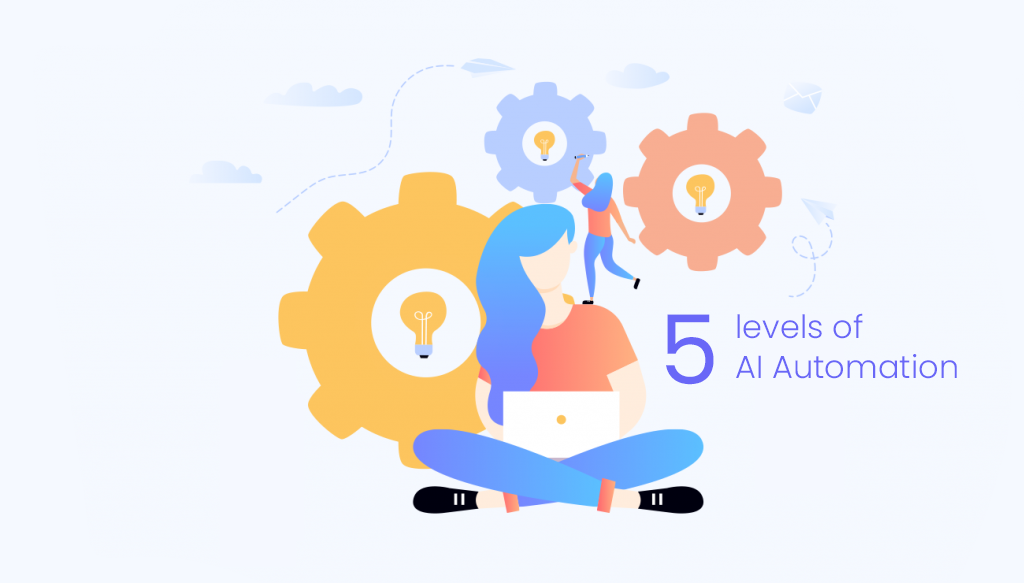The Five Levels of AI Automation

As AI increasingly dominates headlines, it’s important to highlight the differences in AI capabilities. One of the earliest uses of a five-level classification system for AI came from the self-driving car industry. This method of distinguishing capabilities also provides a road map for understanding how much more there is to achieve with AI.
In 2014, the Society of Automotive Engineers (SAE) published their “SAE J3106 Levels of Driving Automation,” which defines six levels in total, starting from level zero (no automation).
Levels 1 and 2 features are now widely available, including on the author’s 2019 Rav 4 Hybrid, which offers lane centering and adaptive cruise control. These features keep the car centered in its lane and adjust speed to maintain a safe distance behind the car ahead, even if the driver is momentarily distracted. However, at levels 1 and 2, the driver must always be ready to take control. This is why Tesla’s well-known “Autopilot,” which has seen instances of drivers sleeping or playing games, is not certified above level 2. Unfortunately, accidents have demonstrated that this level of automation is still not ready for levels 3 or 4, as human intervention remains necessary.

In the broader realm of AI, we can also apply this classification framework. Language generation has been progressively automated, from basic features like “Autocorrect” on smartphones to more advanced systems like ChatGPT, which can be classified as Level 4.
OpenAI’s GPT-3 (Generative Pretrained Transformer 3), the model behind ChatGPT, is considered to be at Level 4 of AI automation—Autonomous AI Automation. GPT-3 is a language generation model capable of producing human-like text, responding to questions, and generating prompts based on input data. While it operates independently and makes decisions based on its training data and algorithms, it still has inherent constraints and limitations, and cannot make autonomous decisions beyond its defined scope.
In a similar way, test automation has seen significant advances over the years in the degree of automation achievable. Apptest.ai is proud to be the first (and so far, the only) test automation provider to reach Level 4—fully autonomous. No human intervention is required to execute a successful, useful, and well-documented test.
Level 1: Rule-Based Automation
This is the most basic level of automation, where pre-defined rules and algorithms are used to automate simple, repetitive tasks. These systems are limited in their functionality and decision-making capabilities. For instance, saving a screenshot of an error to a specific file is considered Level 1 automation in mobile app testing.
Level 2: Self-Learning Automation
At this level, systems can learn from data and improve over time, but they still require human input to make decisions. For example, a system that recognizes patterns in test failures and suggests solutions from a predefined list qualifies as Level 2 automation.
Level 3: Limited AI Automation
This level includes systems capable of making decisions based on pre-defined parameters and guidelines, but they remain restricted in their ability to operate outside these boundaries. Most existing test automation tools are at Level 3—they can execute tests randomly but cannot determine which functions should be prioritized based on test progress or typical app usage.
Level 4: Autonomous AI Automation
At this level, AI systems operate independently and make decisions without human involvement within their specific domain. Apptest.ai is a Level 4 automation provider that delivers fully autonomous testing—eliminating the need for human interaction, test scripting, or manual oversight. Powered by machine learning and natural language processing, it automatically determines the most effective pathways for testing.
Similarly, language models like GPT-3 represent Level 4 automation within the domain of language. These models can generate text, answer questions, and create content independently, although their capabilities are confined to their specialized area of expertise.
The key difference with Level 4 automation is that while it achieves full independence, its scope is limited to the specific tasks it was designed for.
Level 5: Augmented AI Automation
This is the highest level of AI automation, representing systems that not only operate autonomously across all domains but also amplify human capabilities. Unlike Level 4 systems that excel in specific areas, Level 5 AI transcends domain boundaries, actively discovering new solutions and optimizing complex processes without predefined rules.
Considered the “holy grail” of automation projects, it’s akin to driverless cars that not only navigate any terrain under any conditions but also predict and adapt to unforeseen events, or AI systems that can transition effortlessly between entirely different tasks, generating new strategies and insights that even human experts may overlook.
Level 5 represents the pinnacle of Augmented Intelligence—an AI capable of not only understanding and learning independently but also augmenting decision-making with superhuman insights. This level of AI doesn’t just automate tasks; it collaborates with human intelligence to expand possibilities, continuously learning, evolving, and enhancing outcomes across any context.